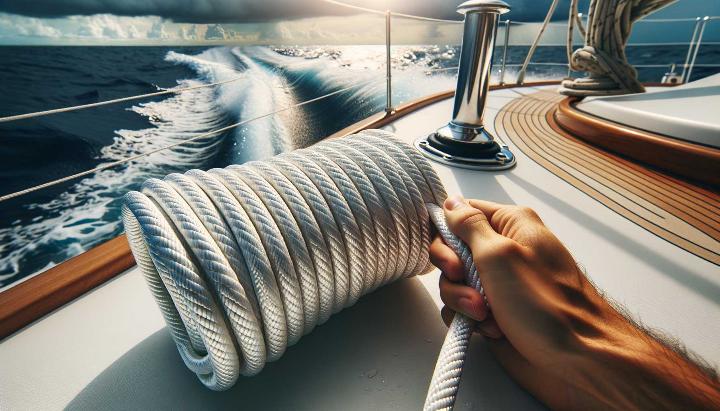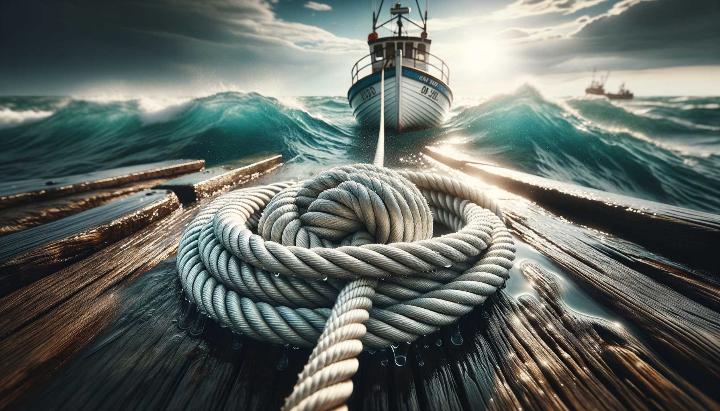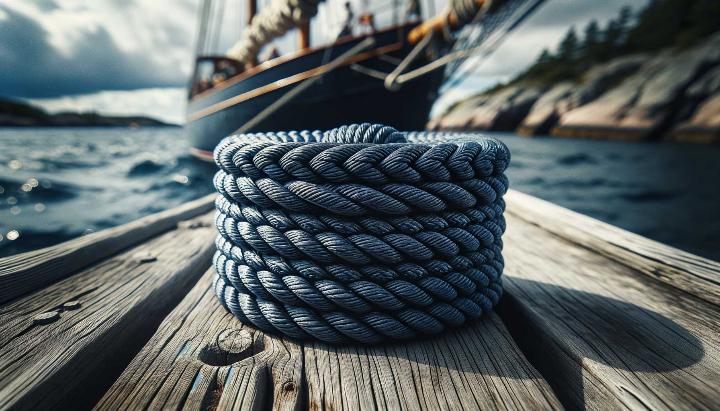Picture this: You're anchored in a serene bay, enjoying the tranquil waters when suddenly, a storm rolls in. Your vessel starts to pitch and roll, and you're left wondering if your anchor line will hold. It's moments like these that separate the seasoned sailors from the novices, and the key difference often lies in one crucial element: a reliable 600 ft anchor line.
At iRopes, we've revolutionised anchor line technology with our double braid construction, specifically designed to withstand dynamic shock loading and keep your vessel steady, even in the roughest waters. But why 600 feet? And what makes our polypropylene line and 100 ft bungee cord combination the ultimate choice for maximising stability?
In this post, we'll dive deep into the world of anchor line essentials, exploring how the right combination of length, material, and shock absorption can transform your anchoring experience. Whether you're a weekend warrior or a professional mariner, understanding these crucial elements could be the difference between a peaceful night at anchor and a nerve-wracking ordeal.
So, batten down the hatches and prepare to discover how iRopes' cutting-edge anchor line solutions can give you the peace of mind you deserve on the water. Your journey to unparalleled vessel stability starts here.
Understanding the Benefits of a 600 ft Anchor Line
When it comes to anchoring your vessel, size really does matter. A 600 ft anchor line isn't just about having more rope - it's about unlocking a world of benefits that can significantly enhance your boating experience. Let's dive into why a longer anchor line might be the game-changer you've been looking for.
Calculating the Ideal Anchor Line Length
Before we delve into the advantages, it's crucial to understand how to determine the right length for your anchor line. The golden rule in the boating world is the 7:1 scope ratio. This means for every foot of water depth, you should have 7 feet of anchor line.
For instance, if you're anchoring in 50 feet of water, you'd ideally want 350 feet of line (50 x 7 = 350). But what if you're venturing into deeper waters or facing challenging conditions? That's where a 600 ft anchor line truly shines.
600 ft Anchor Line
Optimal for depths up to 85 feet, providing extra security and versatility
Advantages of Using a Longer Anchor Line
- Superior holding power: A longer line creates a gentler angle between your boat and the anchor, allowing it to dig in more effectively.
- Versatility in deep waters: With 600 feet at your disposal, you can confidently anchor in a variety of depths, from shallow coves to deeper offshore spots.
- Enhanced shock absorption: More line means more elasticity, which helps absorb sudden movements caused by waves or wind gusts.
- Peace of mind in changing conditions: Tides rise and fall, and weather can be unpredictable. Extra length gives you a buffer against these variables.
Remember, while a 600 ft anchor line offers numerous benefits, it's essential to consider your specific boating needs and storage capacity. Always ensure you're using the right equipment for your vessel and the conditions you're likely to encounter. You may also want to learn about why double braid nylon anchor rope is superior to further enhance your anchoring system.
Have you ever found yourself wishing for a longer anchor line in a tricky anchoring situation? Share your experiences in the comments below - your story might just help a fellow boater avoid a sticky situation!
Choosing the Right Material: Polypropylene Line
When it comes to selecting the perfect anchor line, polypropylene has become a popular choice among savvy boaters. As an experienced sailor, I've found that polypropylene lines offer a unique combination of properties that make them ideal for various marine applications. Let's dive into the world of polypropylene and discover why it might be the perfect fit for your anchoring needs.
Properties and Advantages of Polypropylene Rope
Polypropylene line is a synthetic rope that boasts several impressive characteristics:
- Lightweight and buoyant: This rope floats on water, making it incredibly easy to handle and retrieve. I remember a time when I dropped a heavy nylon rope overboard, and the struggle to fish it out was real. With polypropylene, that's a worry of the past.
- Excellent strength-to-weight ratio: Don't let its light weight fool you. Polypropylene packs a punch when it comes to strength, providing reliable hold without adding unnecessary weight to your vessel.
- Resistant to rot and chemicals: Unlike natural fibres, polypropylene won't deteriorate when exposed to water or harsh marine environments. This durability translates to a longer lifespan for your anchor line.

However, it's important to note that polypropylene does have a lower UV resistance compared to some other synthetic materials. If you're planning to use your anchor line in areas with intense sunlight, consider storing it out of direct light when not in use or opting for UV-treated variants. For more insights, explore our guide on understanding the breaking strength of polypropylene rope.
Comparing Polypropylene to Other Rope Materials
To help you make an informed decision, let's compare polypropylene with two other popular synthetic rope materials:
| Property | Polypropylene | Nylon | Polyester |
|---|---|---|---|
| Strength | Good | Excellent | Very Good |
| UV Resistance | Fair | Good | Excellent |
| Floatation | Floats | Sinks | Sinks |
| Cost | Low | Moderate | Moderate to High |
While nylon and polyester have their strengths, polypropylene shines in situations where floatation and cost-effectiveness are priorities. For example, when I'm anchoring in areas with rocky bottoms or coral reefs, I prefer using a polypropylene line. Its buoyancy keeps it off the seafloor, reducing the risk of snagging or damage. Consider these top-quality polypropylene ropes for your next adventure.
Have you ever used a polypropylene anchor line? How did it compare to other materials you've tried? Share your experiences in the comments below - your insights could help fellow boaters make the right choice for their vessels!
Pro Tip: When using a polypropylene anchor line, consider pairing it with a short length of chain at the anchor end. This added weight helps the anchor set more effectively while still benefiting from the line's buoyancy.
Remember, while polypropylene lines offer many advantages, the best choice ultimately depends on your specific needs and sailing conditions. Consider factors like your typical anchoring depths, local weather patterns, and storage capabilities when making your decision. And as always, regular inspection and proper maintenance of your anchor line, regardless of the material, is crucial for ensuring your safety on the water.
Enhancing Shock Absorption with a 100 ft Bungee Cord
When it comes to anchoring your vessel, stability is key. That's where the unsung hero of marine equipment comes in - the 100 ft bungee cord. As a seasoned sailor, I've learned that this stretchy wonder can be a game-changer in rough waters. Let's dive into how this simple yet effective tool can revolutionize your anchoring system.
Understanding Bungee Cord Properties and Uses
Bungee cords, also known as shock cords or elastic cords, are marvels of engineering. Made from strands of rubber encased in a braided sheath, these cords can stretch up to three times their original length. This elasticity is what makes them perfect for shock absorption in marine applications.
- Stretching capabilities: A 100 ft bungee cord can extend to an impressive 300 ft, providing ample give in choppy conditions.
- Working load limit: Typically, you can safely use about 50% of the cord's length for optimal performance.
- Marine-grade durability: Look for UV-resistant and saltwater-proof cords to ensure longevity in harsh marine environments.

Maximising Shock Absorption Techniques
Integrating a bungee cord into your anchoring system is like giving your boat a set of shock absorbers. Here's how to make the most of this elastic marvel:
- Attach the bungee cord to your anchor line: Use marine-grade shackles or a reliable knot like the bowline to secure the bungee cord between your anchor line and the boat.
- Adjust the tension: Allow enough slack for the bungee to stretch without being fully extended at rest.
- Monitor and maintain: Regularly inspect your bungee cord for wear and tear, replacing it if you notice any fraying or loss of elasticity.
I remember a particularly stormy night off the coast of Tasmania. The waves were relentless, but thanks to my 100 ft bungee cord setup, my vessel rode the swells like a champ. The difference in stability was night and day compared to my previous trips without this shock-absorbing system.
Safety first! Always wear gloves when handling bungee cords and never overstretch them beyond their recommended limit. A snapping bungee cord can cause serious injury.
By incorporating a 100 ft bungee cord into your anchoring system, you're not just improving your boat's stability - you're investing in peace of mind. Whether you're weathering a storm or enjoying a calm day on the water, this simple addition can make a world of difference.
Have you tried using a bungee cord in your anchoring setup? I'd love to hear about your experiences or any questions you might have. Drop a comment below, and let's chat about maximising stability on the high seas!
Double Braid Construction: The Key to Superior Rope Performance
When it comes to anchor lines, the construction of the rope plays a crucial role in its performance. At iRopes, we've perfected the art of double braid construction, a technique that combines strength, durability, and flexibility in one impressive package. Let's dive into why this technology is a game-changer for boaters seeking the ultimate in anchor line performance.
Strength and Durability of Double Braided Ropes
Double braid ropes are like the superheroes of the marine world. They boast an impressive strength-to-weight ratio that puts other rope constructions to shame. Here's why:
- Core strength: The inner core provides the primary load-bearing capacity, typically made from high-strength fibres like polyester or nylon.
- Protective jacket: The outer braided jacket shields the core from abrasion and UV damage, significantly extending the rope's lifespan.
- Synergistic design: The core and jacket work together, distributing load evenly and preventing weak points.
I've seen single-braid ropes fray and wear out after a season of heavy use, but our double braid anchor lines? They keep going strong year after year, even in the harshest conditions. Discover the advantages of using double braid ropes for superior sailing for a seamless experience in dynamic marine environments.

Applications and Advantages of Double Braid Technology
While we specialise in anchor lines, double braid technology shines in various applications:
- Marine use: From mooring lines to halyards, double braid ropes excel in saltwater environments.
- Arborist rigging: Tree care professionals trust double braid ropes for their strength and flexibility.
- Industrial applications: When precision and reliability matter, double braid ropes are the go-to choice.
But let's focus on what matters most to us boaters - anchoring. Our double braid anchor lines offer several key advantages:
- Superior shock absorption: The core and jacket work together to absorb sudden loads, reducing strain on your boat and anchor.
- Excellent handling: The smooth outer jacket makes coiling and deploying the line a breeze, even in wet conditions.
- Consistent performance: Unlike three-strand ropes that can untwist under load, double braid ropes maintain their structure and strength.
I remember a particularly nasty storm off the coast of Queensland. While other boats were struggling with their anchors dragging, my vessel stayed put thanks to the superior holding power and shock absorption of our double braid anchor line. It's moments like these that reaffirm my faith in this technology.
Pro Tip: When choosing a double braid anchor line, consider the material carefully. Polyester offers excellent UV resistance and low stretch, while nylon provides superior shock absorption. At iRopes, we can help you select the perfect blend for your specific needs.
Our commitment to double braid technology isn't just about producing a superior product - it's about giving you peace of mind when you're out on the water. Whether you're facing choppy seas or enjoying a calm day of fishing, you can trust that your iRopes double braid anchor line will keep you steady and secure.
Have you experienced the difference a high-quality double braid anchor line can make? Share your stories in the comments below - we'd love to hear how our ropes have performed for you in challenging conditions!
```htmlEnhance vessel stability with iRopes' shock-resistant 600 ft anchor line, perfect for accommodating deeper waters and unpredictable conditions. This polypropylene line is lightweight, UV-resistant, and floats on water for easy handling and retrieval. Pair it with a 100 ft bungee cord to boost shock absorption, reducing strain during sudden movements and offering peace of mind in rough waters. Crafted with double braid construction, iRopes promises superior durability and performance even under dynamic shock loading, ensuring your vessel remains secure. Explore customised solutions and elevate your anchoring experience with the best in class.
Discover More About Our Custom Solutions
Complete the form above to explore how iRopes' anchor lines can transform your maritime adventures. Our specialists are ready to assist with tailored polypropylene solutions that meet your unique needs, ensuring unmatched safety and reliability at sea.
```